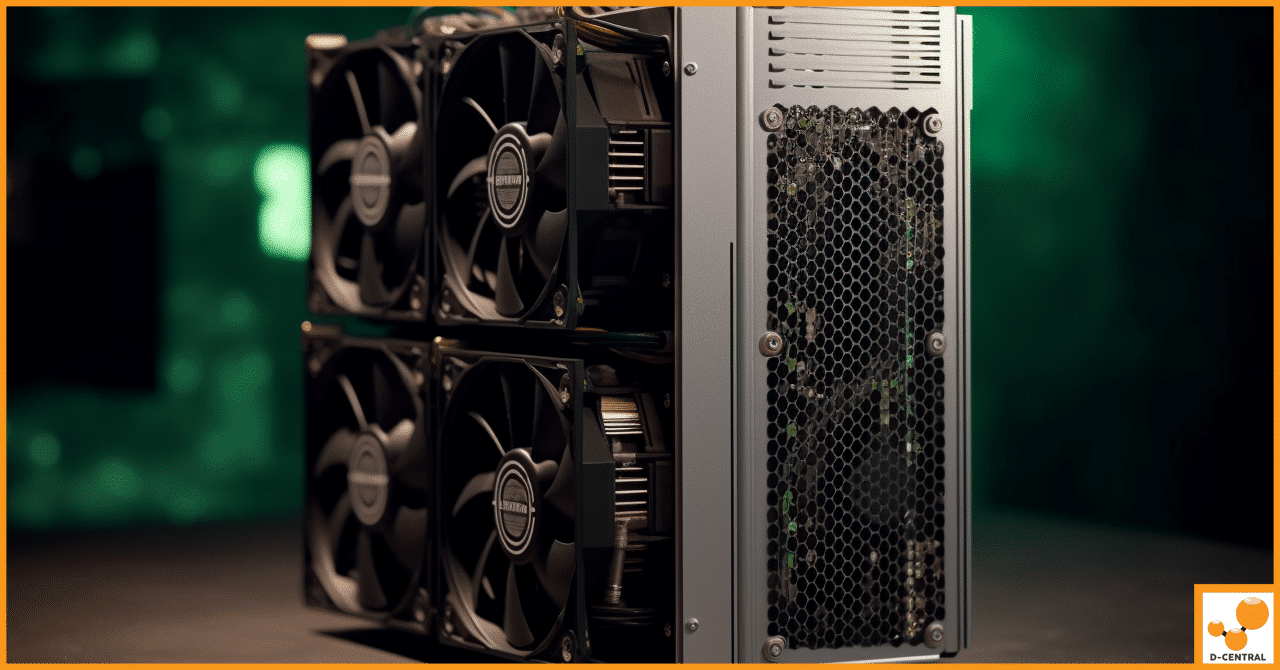
The Antminer S9: Unveiling the Secrets to its Continued Success in the Bitcoin Mining Industry
If you are familiar with the cryptocurrency mining industry, chances are you’ve heard about the Antminer S9. As one of
4479 Desserte Nord Autoroute 440, Laval, QC H7P 6E2

Bitcoin mining, the backbone of cryptocurrency validation and creation, is a process that has captivated enthusiasts and investors alike. At its core, mining involves solving complex cryptographic puzzles to validate transactions on the Bitcoin network, a task that not only ensures the integrity and security of the blockchain but also introduces new bitcoins into circulation as rewards for successful miners. This dual role of transaction validation and currency issuance is critical for the decentralized nature of Bitcoin, making mining an essential component of the cryptocurrency ecosystem.
The journey of mining hardware has been a fascinating evolution, mirroring the rapid growth and innovation within the cryptocurrency space. In the early days of Bitcoin, mining was a pursuit accessible to hobbyists using standard Central Processing Units (CPUs) found in everyday personal computers. However, as Bitcoin gained popularity and the difficulty of mining increased, the need for more efficient hardware became apparent. This led to the adoption of Graphics Processing Units (GPUs), which offered a significant boost in processing power and efficiency compared to CPUs. The quest for even greater efficiency drove the development of Field Programmable Gate Arrays (FPGAs) and ultimately Application-Specific Integrated Circuits (ASICs), which are now the gold standard in Bitcoin mining hardware. ASICs are designed specifically for Bitcoin mining and offer unparalleled performance and efficiency, but their introduction also raised the barrier to entry, leading to the industrialization of Bitcoin mining.
The objective of this article is to delve deep into the world of Bitcoin mining hardware, providing readers with a comprehensive analysis of the current landscape. From exploring the capabilities and features of the latest ASIC models to understanding the factors that influence mining profitability, this article aims to equip readers with the knowledge needed to navigate the complex and ever-evolving mining industry. Whether you’re a seasoned miner looking to upgrade your hardware or a newcomer curious about the mechanics of Bitcoin mining, this guide aims to cover all aspects of mining hardware, ensuring a thorough understanding of what powers the Bitcoin network.
ASIC (Application-Specific Integrated Circuit): ASICs represent the pinnacle of mining technology, designed exclusively for cryptocurrency mining. Unlike their predecessors, ASICs are tailored for optimal performance in a single specific task – solving the cryptographic puzzles of a particular blockchain, such as Bitcoin’s SHA-256 algorithm. Their introduction marked a significant leap in mining efficiency and power, but also centralized mining power to those who could invest in these specialized machines.
GPU (Graphics Processing Unit): GPUs, commonly found in high-performance gaming computers, were once the backbone of Bitcoin mining. Their ability to handle complex calculations simultaneously made them suitable for mining, offering a balance between efficiency and accessibility. GPUs are still used in mining other cryptocurrencies that require different computational tasks unsuitable for ASICs.
Hash Rate: The hash rate measures the computational power of a mining device or network, indicating how many attempts at solving a blockchain puzzle can be made per second. Higher hash rates increase the chances of successfully adding a block to the blockchain, thus earning the associated mining rewards.
Power Efficiency: Power efficiency in the context of mining hardware refers to the amount of electrical energy consumed to perform a certain amount of computational work (usually measured in watts per terahash). Efficient mining hardware maximizes the hash rate while minimizing power consumption, crucial for profitability given the significant energy requirements of continuous mining operations.
Mining hardware is the linchpin of the Bitcoin network’s security and functionality. By performing complex calculations to mine blocks, miners validate and secure transactions, embedding them into the blockchain’s immutable ledger. This process not only thwarts potential double-spending but also distributes new bitcoins in a decentralized manner, adhering to the cryptocurrency’s principles. The collective hash rate of all mining hardware connected to the network fortifies Bitcoin against attacks, making it increasingly difficult for any single entity to manipulate the blockchain.
The evolution of mining hardware has transformed Bitcoin mining from a hobbyist activity into a highly competitive industrial-scale operation. In Bitcoin’s infancy, individuals could mine using simple CPUs in their home computers. The accessibility allowed a broad base of users to participate, fostering decentralization. However, as the network grew and the mining difficulty increased, more powerful GPUs took over, leading to the first significant shift towards specialized mining setups.
The advent of FPGAs and, subsequently, ASICs further escalated the arms race in mining technology. ASICs, with their unparalleled efficiency for Bitcoin mining tasks, rendered previous hardware obsolete for Bitcoin mining and concentrated mining power into fewer hands, those who could afford these expensive, specialized machines. This shift also led to the emergence of mining farms and pools, where individuals combine their computational resources to improve their chances of mining a block and receiving rewards, albeit sharing the profits.
This transition has had profound implications for the Bitcoin ecosystem, raising concerns about centralization and the environmental impact of mining. Yet, it also reflects the growing maturity and professionalization of the Bitcoin network, ensuring its security and functionality as it scales to accommodate a global user base.
In the dynamic world of cryptocurrency, Bitcoin mining remains a pivotal activity, ensuring the security and functionality of the blockchain. As we delve into the top Bitcoin mining machines of 2024, it’s essential to consider several critical factors that influence the selection of the best hardware for mining operations. These criteria include hash rate, energy efficiency, cost, and durability. Each factor plays a significant role in determining the overall performance and profitability of mining hardware.
In comparing these leading models, it’s evident that advancements in mining technology continue to push the boundaries of what’s possible in terms of hash rate and energy efficiency. The Bitmain Antminer series, with its S19 and anticipated S21 models, remains at the forefront, offering a range of options tailored to different mining needs and scales. Canaan’s AvalonMiner series provides reliable alternatives with a focus on cost-efficiency and durability. Meanwhile, MicroBT’s Whatsminer series stands out for its exceptional performance, catering to miners prioritizing hash rate and operational efficiency.
Ultimately, the choice of mining hardware depends on individual goals, operational scale, and cost considerations. By carefully evaluating each model’s performance, energy efficiency, initial cost, and durability, miners can select the most suitable hardware to maximize their profitability in the competitive landscape of Bitcoin mining in 2024.
Selecting the right mining hardware is crucial for anyone looking to enter or expand their presence in the cryptocurrency mining space. The efficiency, profitability, and sustainability of mining operations hinge on making informed decisions regarding the hardware used. Here are some critical factors to consider:
In summary, selecting the right mining hardware involves a careful analysis of hashrate, power consumption, initial costs, operational requirements like noise and cooling, and compatibility with mining pools and software. Balancing these factors according to individual circumstances and market conditions is key to establishing a profitable and sustainable mining operation.
D-Central Technologies stands at the forefront of the Bitcoin mining industry, offering a comprehensive suite of services and products tailored to the needs of both novice and seasoned miners. With a deep-rooted commitment to innovation and quality, D-Central has established itself as a leader in the field, providing reliable and efficient mining solutions that cater to a wide array of mining operations. From individual miners to large-scale mining farms, D-Central delivers expertise and hardware that drive the success of mining endeavors.
Key contributions of D-Central to the mining industry include:
Understanding that one size does not fit all in the mining world, D-Central prides itself on offering custom solutions and modifications that cater to the unique requirements of each mining operation. These bespoke services include:
In an industry often criticized for its environmental impact, D-Central Technologies is dedicated to promoting sustainability and energy efficiency within the mining sector. This commitment is evident in several key initiatives:
D-Central Technologies continues to lead by example, demonstrating that it is possible to achieve profitable Bitcoin mining while adhering to principles of sustainability and efficiency. Through its innovative solutions, custom services, and dedication to the mining community, D-Central is shaping the future of Bitcoin mining, making it more accessible, efficient, and environmentally responsible.
Creating an efficient and profitable mining setup requires careful planning and execution. Here’s a step-by-step guide to help you establish a solid foundation for your mining operations, along with insights into software requirements, optimal configurations, and maintenance tips.
Choosing the right Operating System (OS) is crucial for the smooth operation of your mining setup. The OS should not only be one that you’re comfortable using but also support your mining hardware and software. Popular choices among miners include:
The mining software is the backbone of your operation, connecting your hardware to the blockchain and mining pool. It’s essential to choose software that is compatible with your cryptocurrency and hardware. Additionally, proper configuration is key to optimizing hash rates and minimizing invalid shares. Some factors to consider include:
To maximize the efficiency of your mining hardware, you might consider overclocking (to increase hash rates) or undervolting (to reduce power consumption). However, these practices should be approached with caution due to potential risks:
Dust accumulation can hinder airflow and cooling, leading to overheating and reduced efficiency. Regular cleaning of your mining rig is essential to maintain optimal performance.
High operational temperatures can significantly shorten the lifespan of your mining hardware. Utilize software tools to keep a close eye on temperatures and ensure your cooling solutions are adequate.
Software updates often contain important performance enhancements and security fixes. Keeping your mining software and OS up-to-date is crucial for maintaining the efficiency and security of your mining operations.
A reliable power supply is the foundation of a stable mining setup. Employing power management tools can help you optimize electricity usage, striking a balance between performance and cost.
Regular inspections of your mining hardware can help you identify and address potential issues before they lead to significant downtime or damage. This is particularly important if you’re engaging in practices like overclocking.
By adhering to these guidelines and staying abreast of the latest developments in mining technology and strategies, you can enhance the profitability and sustainability of your mining operations, ensuring long-term success in the competitive world of cryptocurrency mining.
The economics of Bitcoin mining is a complex and dynamic field, influenced by a variety of factors ranging from the cost of electricity to the price of Bitcoin itself. As we look towards 2024, understanding these factors becomes crucial for anyone involved in or considering entering the mining space.
Profitability in Bitcoin mining is primarily determined by the cost of electricity, the efficiency of mining hardware, and the current price of Bitcoin. As we move into 2024, several trends are worth noting:
Bitcoin halving events, which occur approximately every four years, reduce the reward for mining a new block by half. The most recent halving in 2020 reduced the block reward from 12.5 to 6.25 bitcoins, and the next event is expected in 2024. These halvings:
Given the challenges and uncertainties in Bitcoin mining, adopting strategies to maximize profitability is essential:
The economics of Bitcoin mining in 2024 will continue to be shaped by technological advancements, market dynamics, and external factors like energy costs and regulatory environments. By carefully analyzing these factors and employing strategic approaches to mining, individuals and organizations can navigate the complexities of the field and work towards achieving sustainable profitability.
The journey through the intricacies of Bitcoin mining hardware and the broader mining landscape underscores the critical importance of making informed choices when it comes to selecting mining equipment. The right hardware not only enhances efficiency and profitability but also ensures longevity and sustainability in an ever-evolving mining ecosystem.
As we look ahead, the future of Bitcoin mining promises continued innovation and technological advancements. The evolution of mining hardware is expected to focus on increasing energy efficiency, reducing environmental impact, and making mining more accessible to a broader audience. These developments will likely be driven by both the competitive nature of the mining industry and the growing emphasis on sustainable practices.
D-Central Technologies stands at the forefront of this dynamic field, offering a range of top-tier mining solutions designed to meet the needs of both novice and experienced miners. With a commitment to quality, innovation, and customer service, D-Central is dedicated to empowering miners with the tools and knowledge they need to succeed in the competitive world of cryptocurrency mining.
We invite you to delve deeper into the world of Bitcoin mining with D-Central Technologies. Whether you’re looking to start your mining journey or seeking to optimize your existing operations, D-Central offers a wealth of resources, expert advice, and cutting-edge hardware to help you achieve your mining goals.
In conclusion, the path to successful Bitcoin mining is paved with challenges, but with the right partner and the right tools, these challenges can be transformed into opportunities. D-Central Technologies is here to guide you every step of the way, providing the support, hardware, and knowledge you need to thrive in the dynamic world of Bitcoin mining.
What is Bitcoin mining?
Bitcoin mining is the process of validating transactions and adding them to the blockchain ledger, as well as releasing new bitcoins into circulation. It involves solving complex cryptographic puzzles, which requires computational power.
How has Bitcoin mining hardware evolved?
Bitcoin mining hardware has evolved from CPUs (Central Processing Units) to GPUs (Graphics Processing Units), followed by FPGAs (Field Programmable Gate Arrays), and finally to ASICs (Application-Specific Integrated Circuits), which are currently the standard for efficiency and performance in mining operations.
What factors influence the profitability of Bitcoin mining?
Profitability in Bitcoin mining is influenced by several factors, including the cost of electricity, the efficiency of the mining hardware, the current price of Bitcoin, and the mining difficulty level.
What are ASICs in Bitcoin mining?
ASICs, or Application-Specific Integrated Circuits, are specialized hardware designed exclusively for mining cryptocurrencies. They offer the highest efficiency and performance compared to previous technologies but have higher upfront costs.
What is the importance of selecting the right mining hardware?
Selecting the right mining hardware is crucial for ensuring the efficiency, profitability, sustainability, and longevity of mining operations. It involves considering factors such as hash rate, power consumption, initial costs, and compatibility with mining software.
What are the top Bitcoin mining machines in 2024?
The article highlights several top Bitcoin mining machines, including the Bitmain Antminer S21, S19k Pro, S19j Pro, S19 Pro, S19, Canaan AvalonMiner A1326 & A1346, and MicroBT Whatsminer M60S, M63S, M66S, based on their hash rate, energy efficiency, and overall performance.
How does D-Central Technologies contribute to the Bitcoin mining industry?
D-Central Technologies offers comprehensive services and products for Bitcoin miners, including expert consultation, state-of-the-art mining equipment, hosting services, and custom solutions. They focus on innovation, quality, and sustainability in the mining sector.
What are some strategies for maximizing Bitcoin mining profitability?
Strategies for maximizing profitability include prioritizing energy-efficient hardware, joining mining pools, optimizing operations, hedging market risks, and staying informed about industry advancements and market dynamics.
DISCLAIMER: D-Central Technologies and its associated content, including this blog, do not serve as financial advisors or official investment advisors. The insights and opinions shared here or by any guests featured in our content are provided purely for informational and educational purposes. Such communications should not be interpreted as financial, investment, legal, tax, or any form of specific advice. We are committed to advancing the knowledge and understanding of Bitcoin and its potential impact on society. However, we urge our community to proceed with caution and informed judgment in all related endeavors.
Related Posts

If you are familiar with the cryptocurrency mining industry, chances are you’ve heard about the Antminer S9. As one of

In a world constantly evolving with new ideas and technologies, understanding the dynamics that determine the longevity and relevance of

In the digital age, Bitcoin has emerged as a revolutionary financial instrument, reshaping our understanding of currency, transactions, and financial